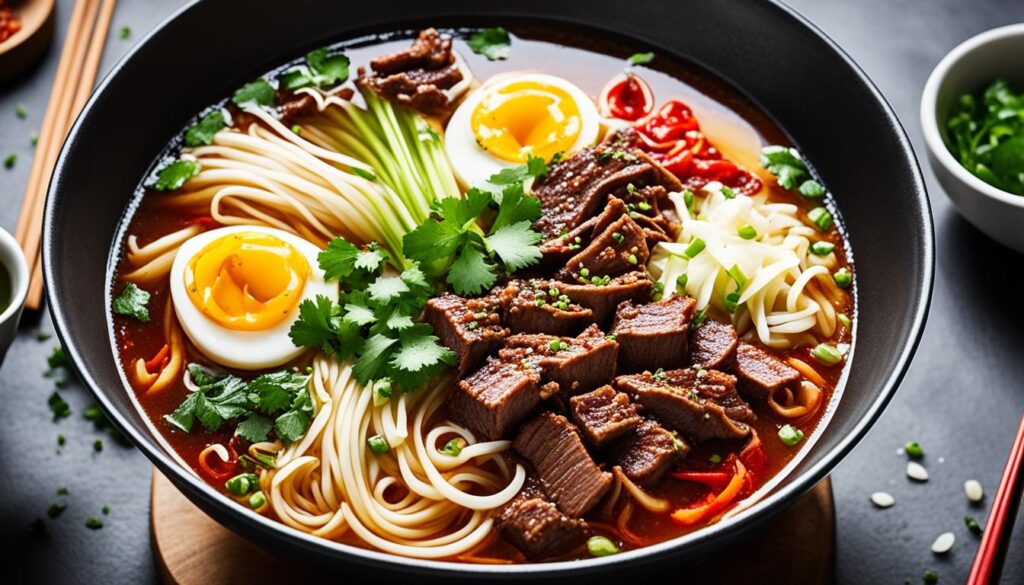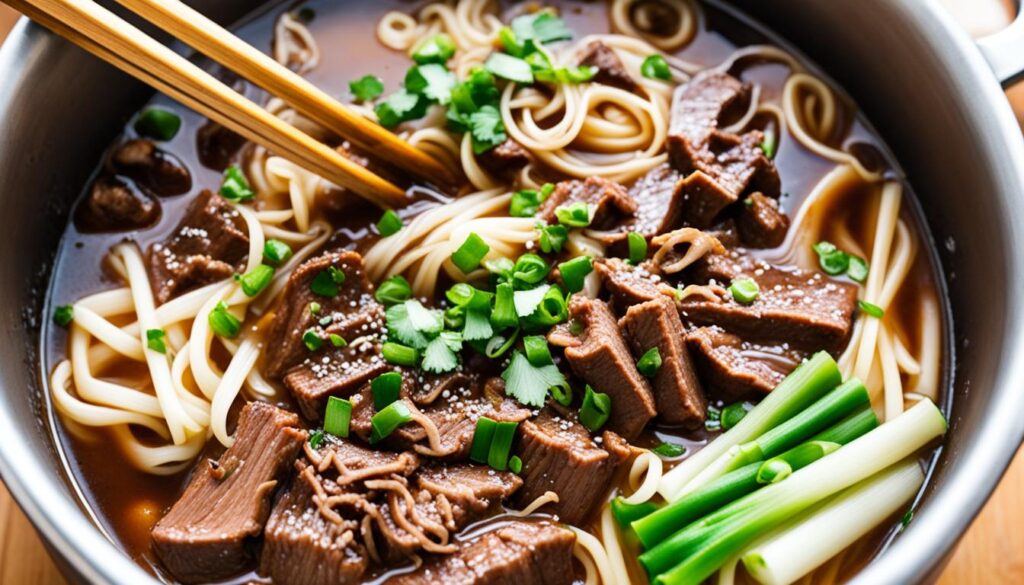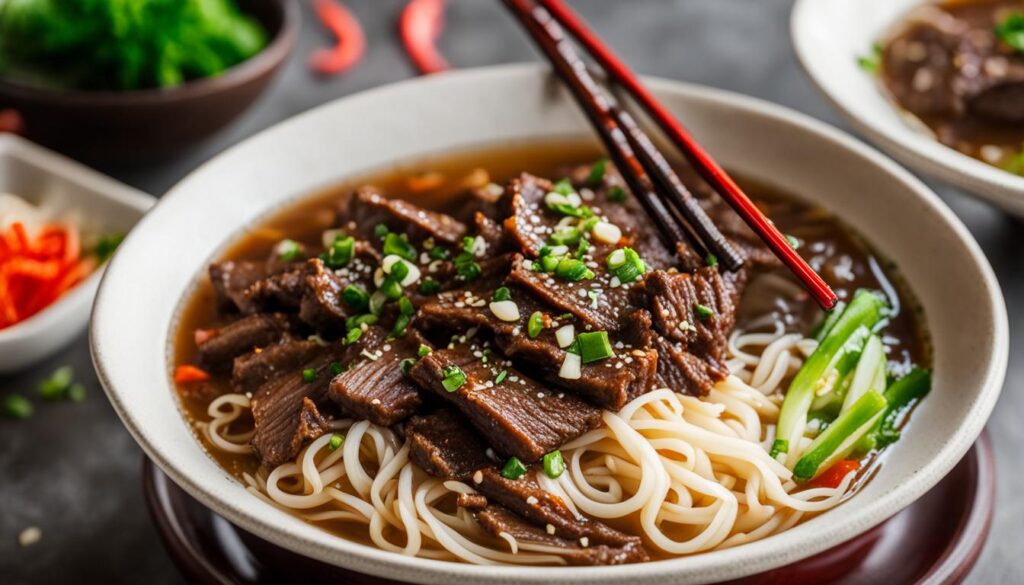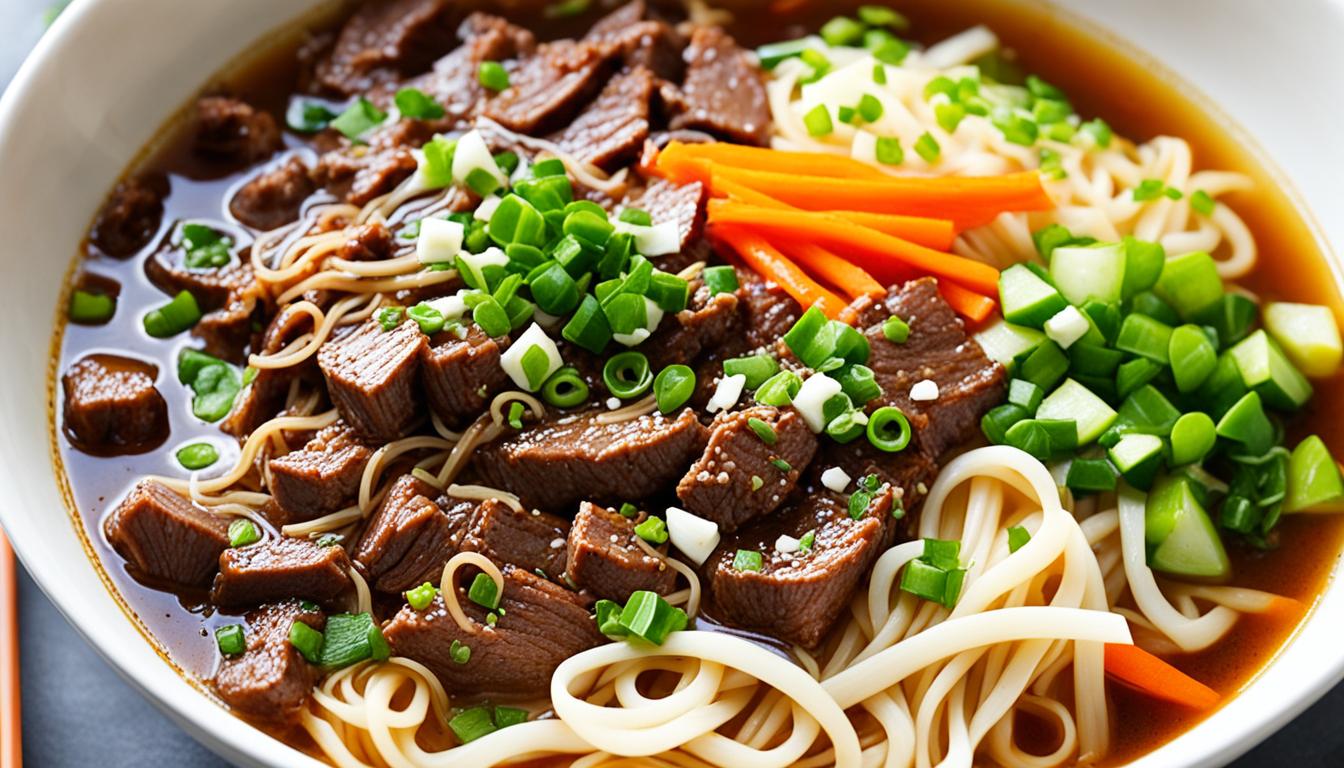Are you tired of the same old instant noodles? Looking to level up your noodle game with a homemade twist? We have the perfect recipe for you. Prepare yourself for a bowl of steaming hot, flavor-packed goodness with our spicy Korean beef noodle recipe inspired by the popular Shin Cup instant noodle brand.
By using collagen-rich short ribs or oxtails, simmered until fork-tender in a combination of dashi and chicken stock, we create a broth that is both rich in flavor and body. But we don’t stop there. Browning the beef and aromatics until nicely charred adds a roasty dark caramel flavor that elevates the dish even further.
And let’s not forget about the heat. We add kimchi juice, gochujang, and fermented Sichuan chile-bean paste to give this dish its signature spice and lactic tang that enlivens the broth. Crisping the shredded beef in a skillet and finishing the bowls with it adds even more flavor and texture.
So, are you ready to embark on a culinary adventure that will redefine your noodle experience? Let us guide you through the steps of creating your own homemade shin cup style spicy Korean beef noodles.
Key Takeaways:
- Elevate your instant noodle game with a homemade twist on the popular Shin Cup brand.
- Using collagen-rich short ribs or oxtails adds flavor and body to the broth.
- Browning the beef and aromatics creates a roasty dark caramel flavor.
- Kimchi juice, gochujang, and fermented chile-bean paste bring the heat and lactic tang to the dish.
- Crisping the shredded beef adds extra flavor and texture.
The Origins of Instant Ramen
When it comes to convenient and satisfying meals, instant ramen has become a staple in many households. With its quick cooking time and delicious flavors, it has captured the hearts and taste buds of people around the world. But have you ever wondered about the origins of this beloved dish?
Japanese instant ramen, the precursor to the popular Shin Cup brand, was first created in 1958 by Momofuku Ando. Ando wanted to provide a simple and affordable way for people to enjoy a hot bowl of ramen at home. He developed a technique of flash-frying noodles, which allowed them to cook quickly when added to boiling water. This innovation revolutionized the world of instant noodles and made them accessible to the masses.
Inspired by the success of Japanese instant ramen, Korean instant ramyun emerged as a variation of the original dish with distinct Korean flavors. Ramyun, which means “instant noodles” in Korean, took the basic concept of instant ramen and added spicy, savory, and garlicky flavors that are characteristic of Korean cuisine.
“The invention of instant ramen was a game-changer in the culinary world. It provided a convenient and delicious meal option for people with busy lifestyles,” says Chef Park Kyung-Soon, a renowned expert in Korean cuisine.
The Shin Cup instant noodle brand is one of the most popular and well-known Korean instant ramyun brands. It is known for its fiery and robust flavor profile, combining the spiciness of gochujang (Korean red chili paste), the savory richness of beef, and the aromatic intensity of garlic. Shin Cup has gained a loyal following of fans who crave its bold and satisfying taste.
Now that we’ve explored the origins of instant ramen, let’s dive into the details of creating a homemade version of the Shin Cup style spicy Korean beef noodle soup.
The Origins of Instant Ramen
| Origin | Year | Inventor |
|---|---|---|
| Japan | 1958 | Momofuku Ando |
| Korea | 1965 | Samyang Foods |
Table: Origins of Instant Ramen
Building a Flavorful Broth
When it comes to homemade Korean noodle dishes, a flavorful broth is essential to elevate the dish to a new level of taste and satisfaction. In this spicy beef noodle recipe, the broth is the heart of the dish, providing a rich and aromatic base for the noodles and beef to shine.
To create a truly delicious broth, we combine homemade dashi broth with beef stock and a variety of aromatic ingredients. The combination of flavors and textures creates a complex and satisfying broth that will keep you coming back for more.
To start, we use collagen-rich short ribs or oxtails to add body to the broth. These cuts of meat simmer in the broth, releasing their natural gelatin and infusing the broth with a deep, savory flavor. Browning the beef and aromatics adds an extra layer of complexity and richness to the overall taste profile.
In addition to the beef, we add black pepper, green onions, garlic, ginger, mushrooms, and chilies to the broth. These aromatic ingredients provide depth and complexity, enhancing the overall flavor of the dish.
To add spice and tanginess, we incorporate kimchi juice, gochujang, and fermented chile-bean paste into the mix. These ingredients not only bring the desired heat to the dish but also impart a unique tang that complements the other flavors in the broth.
Finally, the broth is simmered for several hours to develop depth of flavor. This slow cooking process allows all the ingredients to meld together, creating a broth that is rich, aromatic, and full-bodied.
The homemade broth is the star of this Korean beef noodle soup. Its robust flavor, combined with the tender beef and hearty noodles, creates a truly satisfying and delicious dish.
Ingredients for the Flavorful Broth:
- Collagen-rich short ribs or oxtails
- Dashi broth
- Beef stock
- Black pepper
- Green onions
- Garlic
- Ginger
- Mushrooms
- Chilies
- Kimchi juice
- Gochujang
- Fermented chile-bean paste

Creating a Homemade Dashi Broth
When it comes to making homemade spicy Korean noodles or a flavorful Korean beef noodle bowl, a key component is the broth. In this recipe, we elevate the broth by creating a homemade dashi broth from scratch. Dashi broth is a traditional Japanese stock that adds depth and umami flavor to dishes, including the famous Shin Cup style spicy Korean beef noodles.
To make the homemade dashi broth, we use two primary ingredients: giant sea kelp and smoked dried bonito flakes (katsuobushi) or tiny dried sardines. The sea kelp provides glutamic acid, and the bonito flakes or dried sardines contribute inosinic acid. When combined, these acids create a harmonious umami taste that enhances the overall flavor profile of the broth.
To create the dashi broth, follow these steps:
- Fill a medium-sized pot with water and add a piece of giant sea kelp (kombu).
- Place the pot over medium heat and gradually bring it to a simmer.
- Just before the water comes to a boil, remove the sea kelp to prevent bitterness.
- Add approximately 1 cup of smoked dried bonito flakes or tiny dried sardines to the pot.
- Continue simmering the broth for about 5 minutes.
- Strain the broth through a fine-mesh sieve or cheesecloth to remove any solids.
- Your homemade dashi broth is ready to be used in your homemade Shin Cup style spicy Korean beef noodles or any other delicious Korean noodle dishes!
By making your own dashi broth, you can ensure a more natural source of glutamates and inosinates compared to commercial MSG. The homemade dashi adds complexity and depth to your dish, making it truly authentic and flavorful.
So, why settle for instant noodles when you can enjoy the rich flavors of homemade spicy Korean noodles with a homemade dashi broth? Let’s take your noodle game to the next level!
Table: Ingredients for Homemade Dashi Broth
| Ingredients | Quantity |
|---|---|
| Giant sea kelp (kombu) | 1 piece |
| Smoked dried bonito flakes (katsuobushi) or tiny dried sardines | 1 cup |

Using Short Ribs for Flavor and Texture
When it comes to creating a delicious and satisfying Korean beef noodle recipe, using short ribs is a popular choice. Short ribs are known for their rich and meaty flavor, making them the perfect addition to this dish. But it’s not just the taste that makes them a standout ingredient; it’s also their unique texture and ability to add body to the broth.
Short ribs are rich in connective tissue, which converts to gelatin during the cooking process. This gelatin gives the broth a luxurious and velvety mouthfeel, creating a truly hearty and comforting soup. The result is a broth that is not only flavorful but also has a rich and satisfying consistency.
Browning for Extra Flavor
To enhance the flavor of the beef, we recommend browning it before simmering it in the broth. Browning the beef caramelizes the natural sugars in the meat, resulting in a deeper, more robust flavor. It adds an extra layer of complexity to the dish and elevates the overall taste experience.
By taking the time to brown the beef, you’ll achieve a deeper level of flavor that perfectly complements the other ingredients in the soup. It’s a small step that makes a big difference in the final result.
Adding Texture and Garnish
After simmering the beef until tender and flavorful, it’s time to shred it and add it back to the soup. This not only creates a delicious and satisfying texture but also adds a visually appealing element to the dish.
When serving the Korean beef noodles, the shredded beef serves as a garnish, giving the dish an enticing appearance. Plus, the tender shredded beef pairs perfectly with the noodles and broth, creating a harmonious balance of flavors and textures.
Incorporating short ribs into this recipe not only enhances the flavor and texture of the dish but also adds a touch of elegance to your homemade shin cup style beef noodles. The rich and meaty short ribs, along with the other ingredients, create a truly delicious and satisfying meal that will impress your family and friends.

As we continue our journey to create the ultimate homemade shin cup style beef noodles, the next section will focus on enhancing the flavor profile of the dish using gochujang and doubanjiang. These ingredients add a spicy and savory kick that takes the noodles to a whole new level of deliciousness.
Enhancing the Flavor with Gochujang and Doubanjiang
When it comes to creating a truly flavorful and satisfying spicy beef noodle recipe, the secret lies in the carefully chosen ingredients. In this homemade shin cup style noodle soup, we take the flavor profile to new heights by incorporating two essential ingredients: gochujang and doubanjiang.
Gochujang, a traditional Korean fermented chili and soybean paste, adds a unique blend of heat and savory umami flavors to the broth. Its rich, complex taste perfectly complements the boldness of the beef and enhances the overall spiciness of the dish. The gochujang gives the soup a distinctive and unforgettable taste that will keep you coming back for more.
But we don’t stop there. To further elevate the flavor, we also include doubanjiang, a Chinese fermented chili-bean paste. This ingredient adds a depth of umami and complexity that perfectly balances the heat from the gochujang. The combination of these two pastes creates a harmonious symphony of flavors that will tantalize your taste buds.
“The gochujang and doubanjiang in this recipe truly take the flavor to the next level. The combination of heat, savory umami, and complex flavors is what makes this spicy beef noodle soup so addictive!” – Rebecca, Spicy Noodle Enthusiast
These carefully selected ingredients contribute to the intense heat and complexity that sets this homemade spicy beef noodle soup apart. By using gochujang and doubanjiang, we ensure that each spoonful is bursting with vibrant, flavorful notes that will keep you craving for more.
| Gochujang | Doubanjiang |
|---|---|
| Traditional Korean fermented chili and soybean paste | Chinese fermented chili-bean paste |
| Spicy and savory flavor | Depth of umami and complexity |
| Enhances the overall spiciness | Perfect balance to the heat |
So don’t shy away from adding gochujang and doubanjiang to your homemade shin cup style beef noodles. These ingredients are key to unlocking the intense flavors that make this dish a true standout.
Choosing the Right Noodles
When it comes to creating a delicious Korean beef noodle bowl with a homemade Shin Cup twist, choosing the right noodles is crucial. The recipe calls for ramen-style noodles, which can be easily found in the Asian section of most grocery stores. These noodles are the perfect choice for this dish, as they have a slightly chewy texture and are able to soak up the flavorful broth, enhancing every bite.
If you can’t find ramen-style noodles, don’t worry! You can also use lo mein noodles or any other type of Asian noodle that you prefer or have on hand. The key is to choose noodles that can hold up well in a hearty and spicy broth, adding substance to the dish and creating a satisfying meal.
If you’re unsure about which noodles to choose, here’s a comparison table that highlights the key features of ramen-style, lo mein, and other Asian noodles:
| Noodles | Texture | Thickness | Best Suited For |
|---|---|---|---|
| Ramen-Style | Slightly Chewy | Medium | Brothy Soups |
| Lo Mein | Soft and Chewy | Thick | Stir-Fries or Noodle Dishes |
| Vermicelli | Thin and Delicate | Thin | Cold Noodle Salads or Spring Rolls |
Remember, the choice of noodles ultimately depends on your personal preference and availability. Whether you stick to the classic ramen-style noodles or venture into other Asian varieties, your homemade shin cup-style spicy Korean beef noodles will be a flavorful and satisfying dish.
Tips for Marinating the Beef
To maximize the flavor of your homemade Korean noodle dishes and create a truly delicious spicy Korean beef noodle recipe, marinating the beef is essential. The marinade infuses the meat with a delightful combination of flavors that will elevate your dish to the next level. Follow these tips to achieve the best results:
- Marinate for at least 30 minutes: For optimal flavor absorption, marinate the beef for at least 30 minutes. This allows the marinade to penetrate the meat and infuse it with the bold and savory flavors of gochujang, green onions, soy sauce, rice vinegar, garlic, ginger, sesame oil, and sugar.
- Consider overnight marinating: For an even more intense flavor, consider marinating the beef overnight. This extended marinating time allows the meat to absorb the marinade thoroughly, resulting in a more tender and flavorful final dish.
By marinating your beef with these carefully selected ingredients, you’ll achieve a homemade shin cup style spicy Korean beef noodle dish bursting with complex and vibrant flavors.
Essential Ingredients for Beef Marinade
| Ingredients | Quantity |
|---|---|
| Gochujang | 2 tablespoons |
| Green onions, finely chopped | 2 tablespoons |
| Soy sauce | 2 tablespoons |
| Rice vinegar | 1 tablespoon |
| Garlic, minced | 4 cloves |
| Ginger, grated | 1 teaspoon |
| Sesame oil | 1 teaspoon |
| Sugar | 1 teaspoon |
One-Pan Cooking Instructions
Preparing homemade shin cup style spicy Korean beef noodles is a breeze with this easy one-pan cooking method. Not only does it save time and effort, but it also ensures minimal cleanup afterward.
Follow these simple steps to create a delicious and comforting bowl of Korean beef noodle soup:
- Start by searing the steak in a hot pan until it browns nicely. This quick searing process helps lock in the flavors and juices, ensuring tender and flavorful beef.
- Once the steak is browned, remove it from the pan and set it aside to rest.
- Add onions, mushrooms, ramen noodles, and the remaining marinade to the same pan. Let them simmer together until the noodles are perfectly tender, absorbing all the delicious flavors.
- While the noodles cook, thinly slice the rested steak.
- Once the noodles are cooked to your liking, add the sliced beef back to the pan along with the reserved sauce from the marinade.
- Gently toss everything together to ensure all the ingredients are evenly coated in the flavorful sauce.
- Garnish the dish with fresh green onions for an added pop of color and flavor.
- Now, your homemade shin cup style spicy Korean beef noodles are ready to be enjoyed! Serve immediately and savor the rich and satisfying flavors.
This one-pan method not only simplifies the cooking process but also allows the flavors to meld together beautifully, creating a harmonious and mouthwatering bowl of homemade Korean beef noodle soup.
Customer Reviews
Our homemade spicy Korean noodles have received rave reviews from our valued customers. They can’t get enough of the delicious flavor and spicy kick that this dish delivers. Here’s what some of them have to say:
“These homemade shin cup style noodles are a game-changer! The depth of flavor and quality ingredients make all the difference. I love the heat and the rich taste of the broth. It’s way better than the instant Shin Ramyun!” – Natalie
“I’ve tried many spicy beef noodle recipes, but this one takes the crown. The combination of homemade noodles and the unique seasoning blend gives it an authentic taste. I couldn’t resist finishing every last drop of the broth!” – Mike
“I’m a fan of DIY cooking, and these homemade spicy Korean noodles exceeded my expectations. The broth is packed with flavor, and the noodles soak it all up perfectly. Plus, the versatility of adding different vegetables or protein is a bonus!” – Sarah
Our customers have also shared some suggestions for personalizing the recipe to suit their preferences. Some have tried substituting onions with carrots to add a touch of sweetness, while others have experimented with different types of noodles, such as udon or soba. Personalize the dish to make it yours and explore a world of flavors!
If you’re looking for an upgrade from the instant Shin Ramyun, our homemade version is the way to go. With its depth of flavor and high-quality ingredients, it’s a step above the rest. Say goodbye to the artificial additives and embrace the richness of homemade spicy Korean noodles!
Nutritional Information
When preparing the homemade shin cup style spicy Korean beef noodles, it’s helpful to have an understanding of the nutritional values per serving. This information can guide you in making informed dietary choices and ensure that the dish aligns with your health goals.
The following table presents the approximate nutritional content per serving of the spicy beef noodle recipe:
| Nutrient | Amount |
|---|---|
| Calories | 420 |
| Carbohydrates | 35g |
| Protein | 18g |
| Fat | 24g |
| Sodium | 950mg |
Keep in mind that these values are estimates and may vary depending on the specific ingredients and brands used in your preparation. Additionally, serving sizes can be adjusted to fit your dietary needs and preferences.
With its balanced combination of protein, carbohydrates, and fats, this homemade dish provides a hearty and satisfying meal option. The nourishing broth and flavorful ingredients make it a delicious choice for any occasion.
Remember, it’s always advisable to consult a healthcare professional or a registered dietitian for personalized nutritional guidance.
Conclusion
This homemade shin cup style spicy Korean beef noodle recipe offers a delectable and flavorsome twist to the renowned instant noodle brand. By using fresh, high-quality ingredients and preparing a homemade broth, we have taken this dish to a whole new level of taste and excellence. The combination of fiery gochujang, succulent beef, and aromatic seasonings creates a captivating and gratifying experience for your taste buds. Get ready to relish the fiery heat and indulge in the satisfaction of a homemade noodle bowl!
